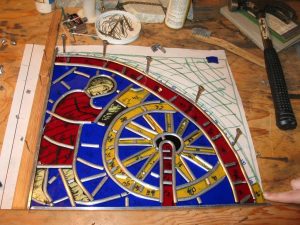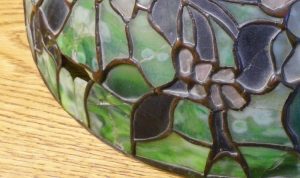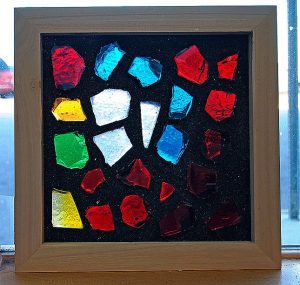Traditional or “Lead Came”

These are the windows you find in the great cathedrals and castles. Colored glass cut and joined together using strips of lead called came. The lead is formed such that there is a channel in which the glass rests. The profile of the lead came resembles a capital letter H. When all the pieces are set together, the artist then melts lead solder into each joint where the lead came meets to join them permanently. After all joint on the front and back are joined, a putty is packed into all the spaces between the lead and glass. This makes the window weatherproof.
The traditional lead came method has been in used since the first centuries to join pieces of glass together into full windows. Small pieces were all that was available in the early centuries of glass blowing. In order to get a flat piece of glass, a glassblower had to spin a blob of molten glass into a flat disc or they blew the glass into a hollow cylinder that was cut open and allowed to lay flat. Either method only produced small segments of flat glass. Those segments had to then be joined using lead.
The introduction of minerals, metals, and salts into molten glass produces colors on which you often find elaborately painted scenes.
Tiffany or “Copper Foil”
The Tiffany Studios are renowned for their production of all kinds of glass objects. In addition to vases, bowls and other blown objects, Tiffany also produced windows and their famous lamp shades. Tiffany often stacked layers of different colors and styles of glass together to achieve desired affects. This left the artist with a thick stack of glass that no lead came would accommodate. Thus, Tiffany pioneered the copper foil method. The artists would pound bands of copper into thin foil strips. These strips were then adhered to the layers of glass with beeswax. All the pieces were laid together in a pattern. When complete, the artist would then use flux to clean the copper foil then melt lead into the seams and gaps between the pieced of glass. This bonded all the pieces into a single mass.
Artists still employee the Tiffany or “Copper Foil” method in their designs. Luckily, we now have commercially available copper foil that is made in standard sizes with an adhesive backing. Can you just imagine pounding copper bars into strips of foil??
An interesting fact is that during Tiffany’s early career as a interior designer he admired the use of stained glass windows but could not achieve the desired affect with the commercially available glass at the time. So, he built a foundry and made his own glass from 1910 to the middle 30’s. He wanted his glass to not only have the colors he desired, but also to communicate texture. Many of the styles of glass that Tiffany pioneered are replicated today. Most of his techniques, manufacturing processes, and colors were lost when he died.
Today, we have commercially available glass that mimics many of the Tiffany styles and textures using modern manufacturing equipment.

Faceted or Dalle de Verre

This technique is also known by its French name of Dalle de Verre which mean “slab of glass”. Artist Jean Gaudin developed this style in Paris in the 1930s. Slabs of colored glass similar to bricks or loaves of bread are cut to shape then the edges are chipped or broken off to achieve facets that will enhance the glass in the same manner as facets on gemstones reflect and refract light. The pieces are set in a pattern, similar to traditional stained-glass work in a bed of sand. The sand bed is encased by a wooden frame. Cement or epoxy resin is used as a type of matrix that is poured between the glass pieces and allowed to dry. The amount of resin used will determine how much of the glass will protrude from the matrix. Less matrix will allow the glass to stand tall and produce interesting textures and shadows. When the matrix is poured level to the tops of the glass, you can achieve interesting depths of color and light.